Affiliate disclosure: This post may contain affiliate links. Please see our Privacy Policy.
Canning beets is an easy way to preserve them for year-round use. Pull out the pressure canner and can plain beets for salads, soups, or just tasty snacks.
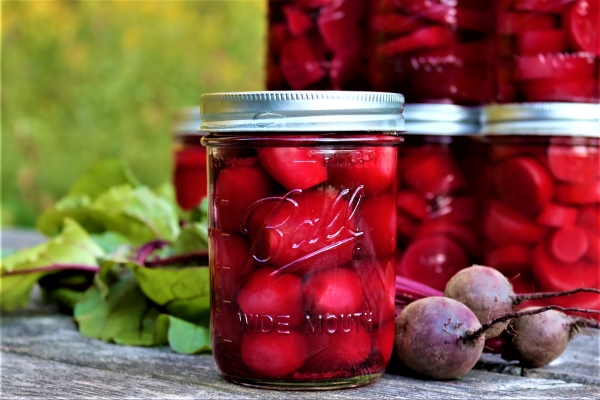
Beets are absolutely perfect for canning, and they hold up to the high temps of a pressure canner beautifully. In truth, it’s actually tricky to tell the difference between a freshly cooked beet and a canned one.
Once canned, beets are ready to eat right out of the jar. I drain them and toss with a bit of homemade feta cheese and a splash of balsamic vinegar for a quick, satisfying salad.
They also perfect for classic beet soups, like chunky Russian borscht or a simple smooth beet soup.
Pressure Canning Beets
Canning beets at home is pretty simple if you’re familiar with how to use a pressure canner.
Beets are a low acid vegetable, and they cannot be canned in a water bath canner. At least so long as you’re canning plain beets.
If you don’t have a pressure canner, try making pickled beets instead, which are canned in a salty vinegar brine. The vinegar acidifies the vegetables enough for water bath canning, but it also really changes their flavor. Pickled beets are tasty as a condiment, but they won’t make a meal.
Personally, I think Canning plain beets is much more versatile, and you can always toss them in salt and vinegar later if you want that tangy flavor.
How to Can Beets
The first step in canning beets is cooking and peeling the roots. Give the beets a quick wash, and then boil them for 15 to 30 minutes (depending on size), until they’re fully cooked through. Test with a fork and drain the beets once a fork can pierce through to the center.
You could spend all afternoon peeling raw beets with a knife, but once cooked skin will just rub right off with your fingers.
Allow the drained beets to cool enough to handle and then rub the skins off the roots.
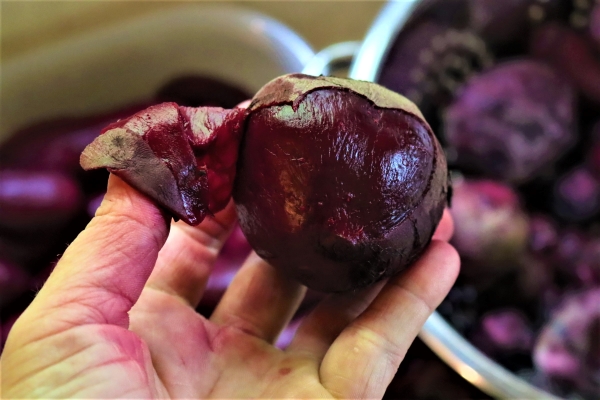
The peels have a bitter flavor and taste a bit like dirt, so it’s important to rub the peels off before packing the beets into jars.
Generally, large beets store well in the refrigerator or root cellar. They’ll keep for months sealed in the crisper, or in a humid cool basement. The larger ones also tend to be more fibrous and don’t taste quite as good as baby beets. The problem is, baby beets really don’t keep outside of canning.
It’s your choice, whether canning baby beets or larger beets. Small beets, under 2 inches in diameter can be peeled and canned whole. Larger beets need to be chopped into cubes or sliced into 1/2 inch slices.
Once peeled, sliced, and prepared, beets are packed into canning jars leaving 1-inch headspace.
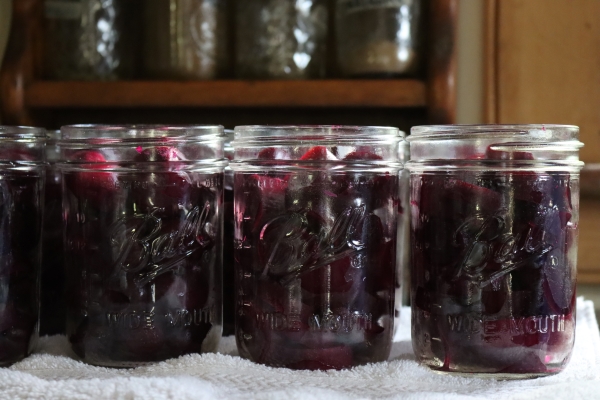
Adding salt when pressure canning beets is completely optional, but you can add about 1/2 teaspoon salt to a pint or a teaspoon to a quart. (Or less, adjust to your taste.)
Personally, I just can them plain in water and salt when I’m cooking with them. That works out well when I’m serving them with salty things like feta because then the finished dish isn’t too salty together.
Add the salt directly into the jar if using, and then pour boiling water over the beets, still leaving 1-inch headspace.
(Use clean, freshly boiled water to pack the beets, not the water you used to cook them initially. That will have an off flavor infused into it from the beet skins.)
Cap the jars with 2 part canning lids and load them into a prepared pressure canner.
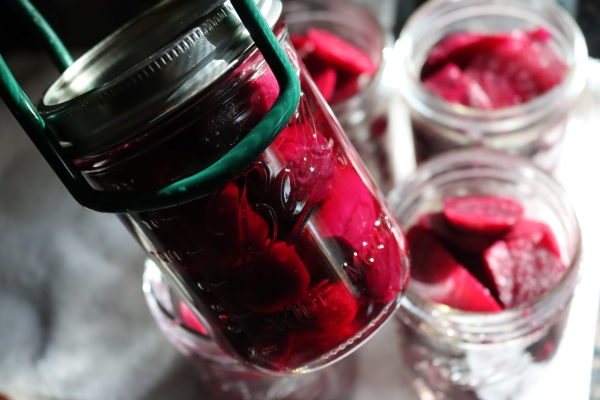
Be sure to prepare the pressure canner according to the manufacturer’s directions, as they all work slightly differently. I’m using an All-American Pressure Canner, which has you add 2-3 inches of water to the bottom of the canner and warm it to a simmer. A trivet is placed under the jars, then the jars are loaded in.
Then seal up the top, but don’t add the canning weight right away. Allow the canner to vent for 10 minutes at high heat to ensure that the chamber is full of steam, then add the canning weight and allow it to come up to pressure.
Once it’s up to pressure, process beets at pressure for 30 minutes for pints and 35 minutes for quarts. The pressure used depends on your elevation as shown in the table below.
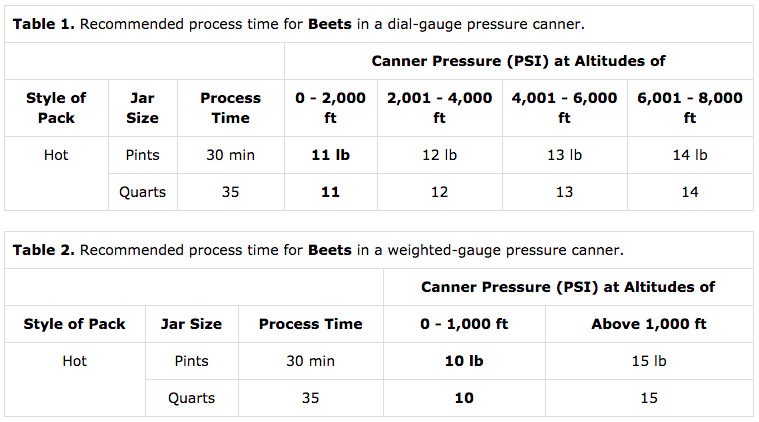
You’ll see that the total processing time doesn’t change, just the pressure.
Once the beets have been at pressure for either 30 minutes for pints or 35 for quarts, turn off the heat and allow the pressure canner to cool naturally.
(This should take several hours, don’t try to rush it.)
After the canner has fully cooled, remove the jars and check seals. Store any unsealed jars in the refrigerator for immediate use.
Properly pressure canned beets should maintain best quality on the pantry shelf for 12-18 months.
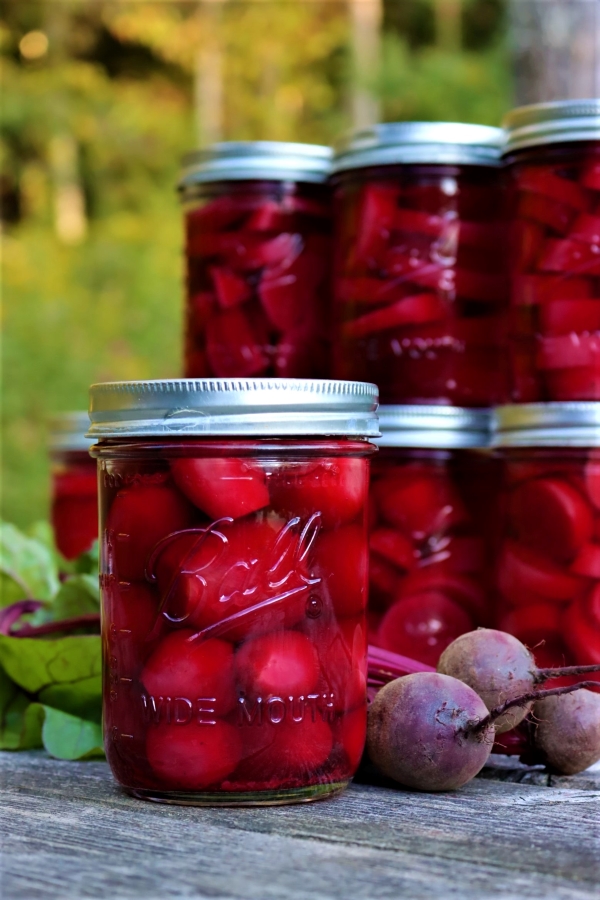
Ways to Preserve Beets
Looking for more ways to preserve beets? Canning is my favorite option, but there are plenty of other ways to put up a bumper crop of beets.
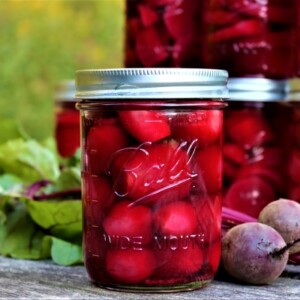
Canning Beets
Ingredients
- Beets
- Water
- Salt, optional
Instructions
- Prepare a pressure canner following the manufacturer's directions. (For most models that means ~ Add water to the bottom, insert trivet, and bring it to a simmer on the stove.)
- Remove tops and tails, and then wash beets.
- Boil beets for 15 to 30 minutes, based on size, until they're fully cooked through. Test with a fork to ensure they're tender all the way through.
- Strain the beets and allow them to cool slightly until they're cool enough to handle.
- Rub the skins off the beets with your hands, and rinse them clean.
- Pack beets into prepared canning jars, leaving 1-inch headspace. Small beets, under 2 inches in diameter, can be packed whole into jars. Larger beets should be sliced into 1/2 inch slices.
- Add salt, if desired. (See note below)
- Bring clean fresh water to a boil and pour it over the top of the beets in the canning jars, still leaving 1-inch headspace.
- Remove any air bubbles, adjust headspace, and then cap with 2 part canning lids.
- Place the jars in a pressure canner on the trivet and cap the lid.
- Allow the canner to vent seam for 10 minutes before sealing with the appropriate weight (or follow the directions on your canner model).
- Allow the canner to come up to pressure, then turn down the heat to maintain the appropriate pressure. Process jars for 30 minutes (pints) or 35 minutes (quarts). See notes for pressure by elevation.
- Once the canning time has completed, turn off the heat and allow the canner to cool completely before opening.
- Remove jars and check seals. Store any unsealed jars in the refrigerator for immediate use.
Properly canned sealed jars of home-canned beets should maintain quality on the pantry shelf for 12-18 months.
Notes
Pressure Canner Recipes
Once you’ve got your beets canned, keep your pressure canner rocking with these pressure canner recipes:
Fall Canning Recipes
Preserving more than beets this fall? I’ve got literally hundreds of canning recipes, and here are a few great ones for the autumn season.
- Canning Apple Pie Filling
- Canning Apple Cider
- Canning Applesauce
- Pear Jam
- Canning Tomatillos
- Husk Cherry Jam
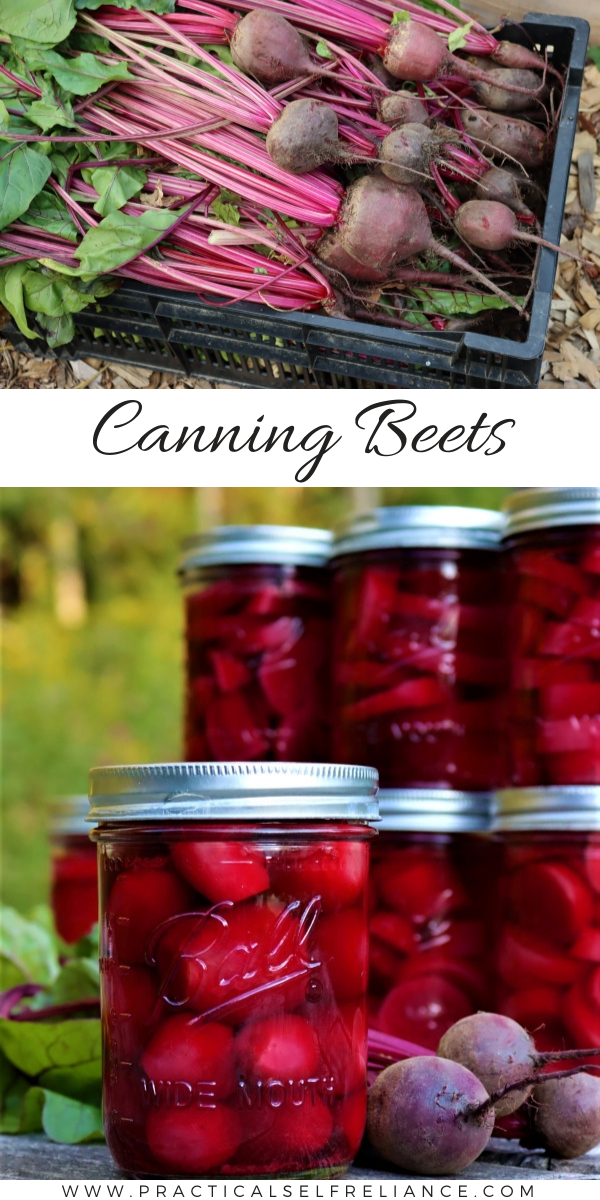
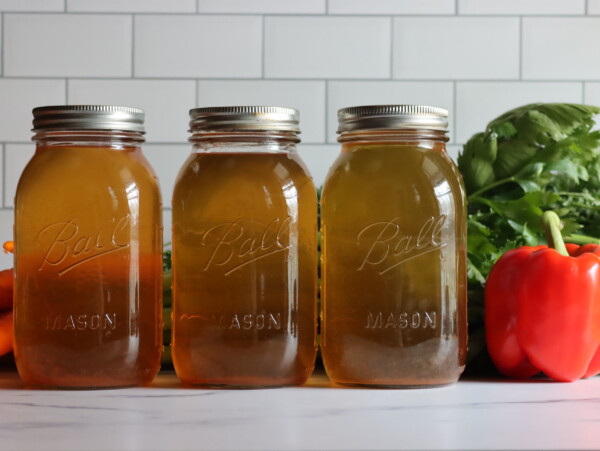
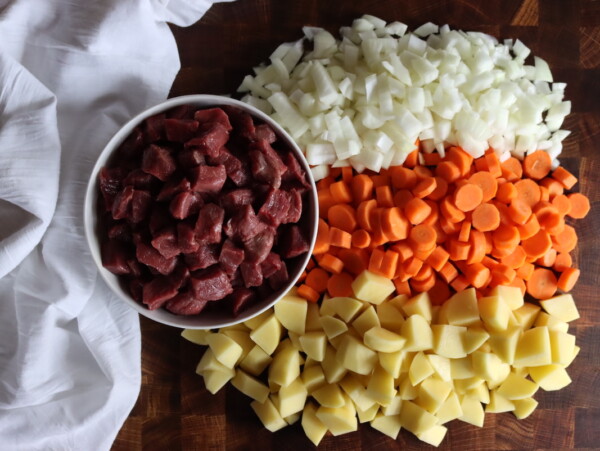
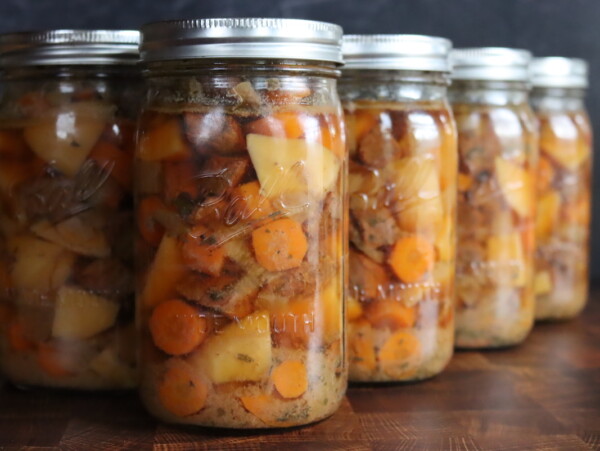

Thanks for making this canning project so understandable. One recipe I looked at failed to mention that you needed to add boiling water to the jars of beets. Fortunately, I’ve canned enough to know that trying to can with no liquid wasn’t going to work. But what if I’d been a beginner? I grew a TON of beets this year. I’ve tried freezing, but just not that crazy about the texture. I’m excited to have canned beets this year.
Canned beets are a staple in my house, I absolutely love them. I’ll drain a jar for lunch with a little diced onion and feta, along with a splash of balsamic. Sooo good!
Hi Ashley
I really enjoy your site and recipes. I canned pickled beets and plain beets using your recipes. So happy. I even did Tuna!
Please be well and again thank you.
Tina
Nice, so glad it’s working out for you!
I was curious about the post about putting in jars the plain beets.. So I use a water bath canner.. Never tried pressure cooker jarring.. So the question is why couldn’t I use a water bath canner for plain beets, boiling juices, and salt to jar the beets that are cooked and ready to jar.. Just curious.. Appreciate the info..
Beets are a low acid food unless they are pickled. Low acid foods need to be pressure canned for safety.
I dont have a pressure cooker but use hot water bath on my veggies. Can I use this method to can my plain beets? I have frozen beets, pickled beets and a ton of beets ready to do something with but am not sure about hot bath-any ideas?
Plain beets must be processed in a pressure canner. Only pickled beets can be safely processed in a water bath canner.
do the beets get soft or mushy after the cooking and then canning process?
They tend to keep their shape better if they are kept in larger pieces.
I have an all American presser canner and followed the directions exactly. The beets were nice and dark when I started but were pale when I took them out of the canner. 35 minutes exactly from the first jiggle(after 10 mins of steam-off). A couple lost a fair amount of water. Big disappointment. Beets are part of the reason I bought the canner. Any thoughts? Thanks
As long as at least half of the water is still in the jar, they are safe to eat. It sounds like you may have had some siphoning. This can sometimes happen with extreme temperature changes. Did you leave the lid on the canner until it had cooled completely?
Ashley, thank you so much for all you share with us! In my experience, if the root is cut before boiling, much of the color will bleed out. It will pop off easily with the skins, so I just leave the whole root on while cooking. It could just be the variety I’ve grown, but it might be worth a mention for people new at this. Thank you again for sharing your life with us.
Pickled beets are the condiment of choice in the Great Smoky Mountains, and few meals stick to your ribs better than pinto beans, good cornbread, pickled beets, and a glass of cold buttermilk. Use a sweet vinegar brine and add a teaspoon of pickling spice per pint.
Beet juice has been found to reduce blood pressure and increase athletic endurance, so don’t throw it away.
Nice! I love pickled beets too, we eat them a lot in the winter with breakfasts. Good to know about the beet juice!
You eat beets with breakfast…can you explain that? It seems weird to eat pickles stuff with breakfast so I’m wondering what your breakfasts are like. I love all things pickled!
Oh man! Pickles are great with breakfast, though I’m not talking about pickled cucumber…which really just screams lunch to me. Other pickled veg, like beets or onions are great for adding a bit of bright contrast to otherwise heavy breakfast foods (hash browns, eggs, bacon, etc). No they don’t go on cereal or pancakes, but they’re great for putting on the plate next to heavier oily things like fried potatoes (or in this case, I’m actually referring to latkes, which we serve with applesauce, sour cream, and pickled beets/onions.)
I used to use a recipe that used brown sugar instead of white, lots of spices, apple cider vinegar … so good I used to take a container of pickled beets to work for my lunch with a hard boiled egg and a slice of bread …. so good! received so many stares, ha ha.
I canned beets for the first time this year and they were completely flavourless, not at all like fresh beets, I was so disappointed. Where did I go wrong?
I think it really depends on the variety. I’ve canned pink and striped beet varieties, and they taste a bit washed out. The deep dark red beets have the best flavor when canned in my opinion, and I think these are detroit dark red. You can also add a tablespoon or so of balsamic vinegar to each jar, which will bring out their flavor.